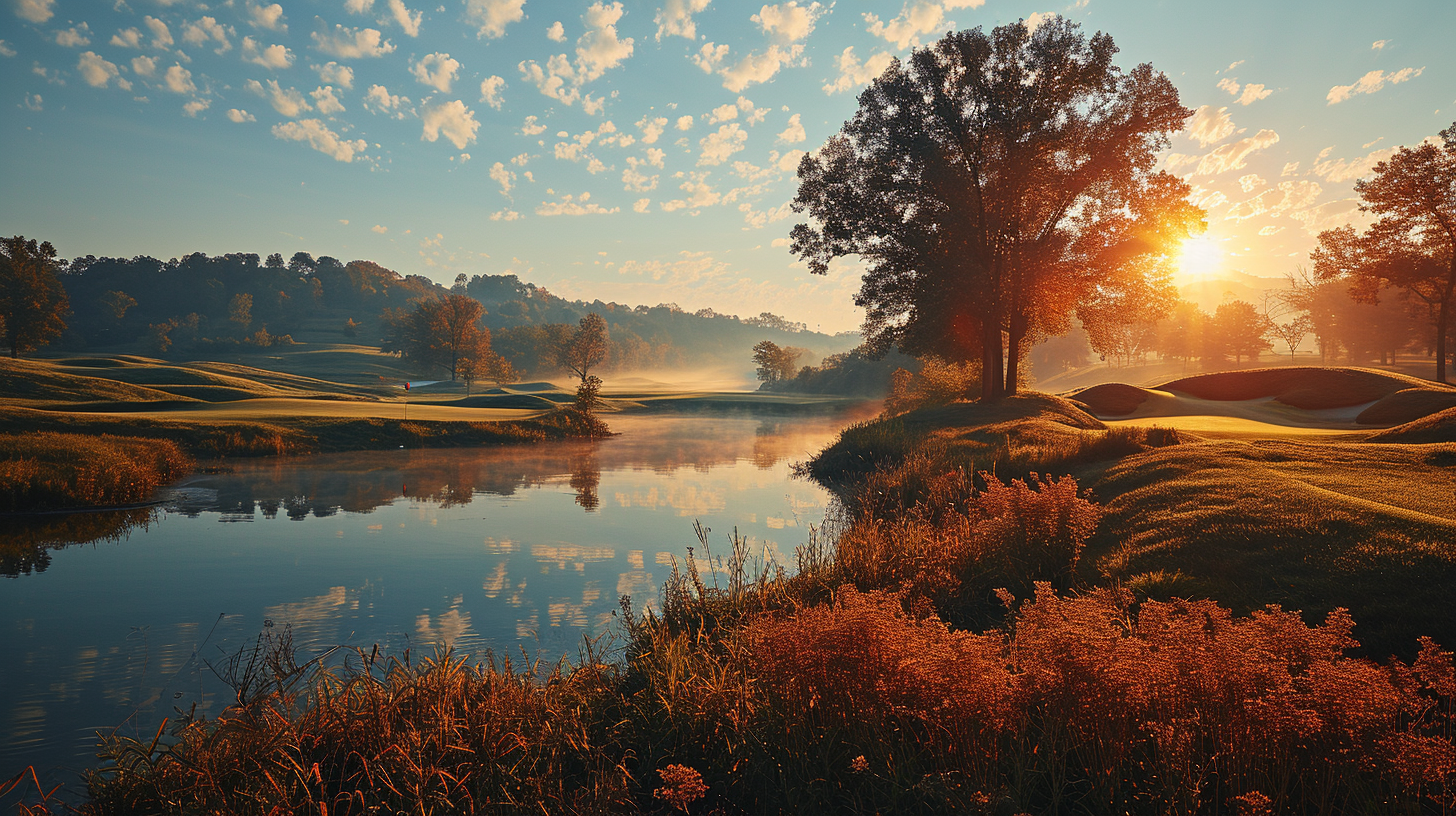Golf’s expansive imprint across America might surprise even the most avid players.
The United States contains far more golf courses than any other country worldwide, with a staggering total reaching above 15,000 facilities nationwide.
Let’s dig in to understand more about where all these U.S. golf courses are located and who has access to play them.
How Many Golf Courses Are There In The United States?

The United States contains a total of 15,372 golf courses as of the year 2021. This number comes directly from annual data aggregated and reported by the National Golf Foundation, the leading authority monitoring quantities of golf facilities across the country.
Total Number Of Golf Courses

When aggregating data across the entirety of the fifty states, one authority stands out as the primary source for comprehensive statistics on quantities of functioning golf courses, both public and private.
The National Golf Foundation (NGF) continually tracks details including openings, closures, and total counts of U.S. golf facilities.
According to the most recently published reports from the NGF, which compile figures from throughout the 2021 calendar year, the United States contains a grand total of 15,372 golf courses as of 2021.
This number encompasses all active facilities spread throughout the fifty states and the District of Columbia. It includes 9 hole courses as well as 18 hole regulation courses.
Also counted are courses of all types from municipal public tracks to resort layouts to private country clubs.
Standing at over fifteen thousand total courses nationwide, the U.S. possesses the most golf courses of any country across the globe. For perspective, the nation with the next highest count is Japan with approximately 2,400 golf courses.
Canada contains around 2,300 while Australia has roughly 1,500. So the United States decidedly leads the world by a wide margin in terms of overall golf facilities.
Breakdown By State

Taking a closer examination of the dispersal of golf courses across the United States reveals interesting trends that demonstrate how certain states dominate in terms of total facilities.
Warm weather year-round and bustling tourism contribute to some states housing far greater quantities of courses than others.
Florida tops all other states by a significant margin with total golf courses numbering over 1,100. The Sunshine State’s warm climate and plentiful sunshine allows comfortable play twelve months of the year.
Retirees and vacationers flocking to Florida supplements the high number of tracks. California comes in second with over 910 total courses, many located around metro regions like San Diego and Los Angeles.
The state also enjoys weather amenable for play during any season.
New York possesses the third most golf courses out of all fifty states, with over 860. The combination of numerous facilities around New York City plus plentiful options in upstate rural regions allows the state to edge closer to the top of the list.
Michigan edges into the fourth spot with approximately 790 golf courses, no doubt benefitting from tourism and second homeowners visiting northern resort towns each summer.
Rounding out the top five, Texas contains over 780 total golf courses thanks in part to popularity in Dallas, Houston and Austin.
On the lower end of the spectrum in terms of total golf courses, a few of the more rural states predictably show quite small numbers. North Dakota reports the fewest courses of any state besides Hawaii and Alaska, with around 50 total tracks.
Neighboring states Montana and Wyoming also demonstrate relatively few golf layouts compared to the nationwide figure, with approximately 65 courses each. Vermont claims around 75 total golf courses across the small New England state.
Ultimately climate and less population density contribute to these states reporting the fewest golfing facilities.
For convenient reference, below appears a table with the top ten states ranked by most overall golf courses along with the associated total number of tracks within each state.
Florida convincingly takes first place while states with the greatest populations and vacation destinations fill most additional spots. The figures provide perspective on which regions of the country offer golfers the greatest number of layout options.
| States | Total Golf Course |
| Florida | 1100+ |
| California | 910+ |
| New York | 860+ |
| Michigan | 790+ |
| Texas | 780+ |
| Ohio | 740+ |
| Pennsylvania | 720+ |
| Illinois | 700+ |
| North Carolina | 695+ |
| Wisconsin | 630+ |
Public Versus Private Courses

In addition to total golf courses per state, further examination of the numbers nationwide reveals a breakdown according to public versus private club status.
Public golf courses remain open for play by any golfers seeking tee times while private country clubs restrict access only to members.
Approximately 7,500 of the 15,372 total golf courses across the fifty states maintain statuses as public golf courses. This means around half of all facilities allow public play.
So travelers or state residents generally find ample public layouts available for booking tee times even though certain exclusive, private clubs exist across the country as well.
The number of private golf courses in the United States sits around 7,900. Most states report a hundred or more private clubs restricting access to members only.
In fact some states see over 500 private clubs comprising a significant portion of their total facilities.
Overall across the nation this equates to a reasonable percentage of golf courses operating as higher end venues with membership policies and amenities above typical public tracks.
In examining trends over the past couple decades, statistics show slight increases in openings of new public golf courses compared to private.
Building new public courses recently became more common as operators work to cater to open player demand rather than relying strictly on club membership rosters.
So the future likely involves marginally higher shares of public versus private facilities while both sectors remain well represented.
Notable/Historic Courses

While the total figures for quantities of golf courses state by state and public versus private prove interesting from a statistical perspective, they fail to tell the full story related to golf landscape.
The numbers alone disregard detail about history and fame regarding some particularly significant golf courses found across the United States.
Indeed America houses many world renowned championship golf courses that host professional tournaments or reflect distinctive designs from iconic architects.
Spotlighting a select few of the most acclaimed layouts better conveys how golf fans revere certain facilities regardless of strictly the total count of courses by state.
These courses represent pillars of the game on a global scale as well as nostalgia for both architects and events.
No listing of notable American golf courses proves complete without Augusta National Golf Club, permanent host venue of The Masters Tournament each April. The list of past champions at Augusta National represents a veritable who’s who of golf legends.
Designed by eminent golf architect Dr. Alister MacKenzie with suggestions from legendary amateur Bobby Jones, the track follows strategic philosophies blending risk-reward options with penalizing pitfalls for wayward shots.
Iconic holes include the tricky 10th through 12th stretch culminating at Golden Bell, the famous par-3 12th hole guarded by Rae’s Creek.
From the lush flora to the honorary Magnolia Lane entryway to various famous landmarks, Augusta National rightfully earned reputation as one of the most prestigious courses anywhere.
Remaining in the state of Georgia, the East Lake Golf Club in Atlanta maintains similar status as an historic American golf club.
Home course of the legendary Bobby Jones in his youth, East Lake hosted many important championships including the 1963 Ryder Cup and a decades long run as host site for The Tour Championship, the PGA Tour’s season finale event.
Recent restorations returned the Donald Ross designed course to glory as the original home of Bobby Jones himself. Today’s Tour professionals once again follow in Jones’s footsteps competing each fall at East Lake.
Looking at more recent icons of American golf course architecture, Pinehurst Resort in North Carolina contains multiple world class layouts with rich histories.
Both courses No. 2 and No. 4 served as host sites for past U.S. Opens, U.S. Women’s Opens and other prominent championships. The Donald Ross masterpieces now operate under the experienced ownership of billionaire Bob Dedman.
With their trademark crowned greens and strategic bunkering, the Pinehurst tracks rightfully earned honors as premier inland links style designs. Modern architects frequently reference Pinehurst as inspiration.
Traveling cross country to the Monterey Peninsula south of San Francisco reveals iconic golf courses of a starkly different style than Pinehurst. Along the rugged Pacific coastline, golf venues including Pebble Beach Golf Links, Cypress Point Club and Spyglass Hill captivate fans.
Hugging cliffsides high above the pounding surf of Stillwater Cove, the epic oceanfront sites maximize dramatic views and integrate the stunning natural landscape.
Architects including Jack Neville and Alister MacKenzie made the most of the stellar settings to create truly one-of-a-kind golfing experiences offering equal parts beauty and challenge.
Tournament viewers around the globe witness scenes of Pebble Beach hosting frequent major championships aired each year on broadcast TV.
Many more examples exist across the American golf landscape showcasing history and fame through architectural icons or annual big events. Oakmont Country Club near Pittsburgh challenges the world’s best during U.S.
Opens with its deep bunkering and thick rough bordering lightning fast greens. The Ocean Course at Kiawah Island in South Carolina, Harding Park in San Francisco and even Torrey Pines Municipal in La Jolla built their own championship legacies.
This abbreviated list provides a glimpse of America’s ability to develop golf courses now considered household names to fans and players worldwide. Their rich histories stand out from simply showcasing raw data on total facilities per state.
Recent Course Openings/Closings

Shifting from discussion strictly regarding some of the most storied golf courses in existence to examination of trends in recent new course construction merits reviewing as well.
Even in America with over 15,000 facilities already operating, golf course architects and investors continue developing new layouts each year in hopes of attracting player interest and tourism.
As the preceding section mentioned, modern architects frequently find inspiration from time honored classics like Pinehurst No. 2 or Pebble Beach Golf Links. They aim to incorporate design attributes contributing to elite architecture pedigrees at these facilities.
However viable land in short supply plus high initial investment pose barriers to building new courses. Reciprocally, a wave of course closures commenced around fifteen years ago during economic downturns.
So analyzing openings versus closures sheds light on the net change in total American golf courses in recent years.
During the 2021 year alone, over 200 brand new golf courses opened for play across the United States. Each represents municipal designs, daily fee resort layouts and even a few new private clubs mixed in.
This somewhat substantial figure contradicts the assumption that course construction dropped off long ago. In reality opportunities still occasionally arise to introduce entirely new tracks.
The largest plurality of new course openings occurred in active retirement regions like Florida and Arizona where reasonable land access hopefully supports bookings from golf loving transplants.
Additional facilities debuted around booming southern metros reminiscent of years when Atlanta, Charlotte and Texas witnessed a development boom. Teaching focused par-3 tracks represent a chunk of openings as operators aim to attract novices.
The two hundred-plus newcomers run the gamut from small hometown public plays to championship venues already landing tournaments.
During the matching 2021 timeframe however, approximately two hundred American golf courses also officially closed down and ceased operations.
Reasons include aging facilities no longer drawing enough play to justify maintenance expenses, repurposing land for different development, or reverting to natural open spaces in certain cases.
Most closures transpire in regions with shorter outdoor seasons or signs of economic decline.
So on the surface during 2021 the net change in terms of golf course openings minus closures roughly balanced out to show neither substantial gains nor major losses. The sport witnessed near equilibrium with only a couple extra openings on record.
This stabilizing effect continues several consecutive years now following a spell with more closures than debuts.
While unlikely for the U.S. to witness mid century boom eras again, evidence suggests adequate economic viability remains to sustain most the fifteen thousand-plus American golf courses assuming proper upkeep and modernization. Supply changed little recently.
Select examples of highly acclaimed new course openings further demonstrate how designers and investors still believe in golf’s popularity.
The Loop at Forest Dunes in Michigan opened to much fanfare in 2018 thanks to an inventive reversible routing letting players set out in either direction. The course garnered awards and now hosts an event on the professional LPGA Tour showcasing unique flexibility.
Another modern creation by architect Tom Doak called Ballyshear Golf Club northwest of Chicago earns praise as well. Doak leans on trusted strategic philosophiessurely to breed future acclaim at Ballyshear.
Down south near Augusta, Georgia, new private club Spring Island recently matured from construction into a fully functioning club now accepting select members. With architecture by Tom Fazio, Spring Island impresses visually while emphasizing environmental sustainability.
These prominent cases reinforce that strong economic conditions may again allow for highly successful new golf courses in America built both publicly and privately even if total supply changes little year to year nationwide.
The sport retains appeal for all player types from traveling visitors to avid members.
Conclusion
Reviewing the tally of over 15,000 total golf courses dispersed across the United States paints part of the picture when quantifying availability from a macro perspective.
Zooming into state by state numbers and ratios of public versus private courses adds helpful dimension as well for understanding true access.
Detailing famous courses ingrained as pillars tied to history and events takes the analysis one step further to demonstrate how raw counts alone fail to indicate prestige on renowned layouts like Augusta National or Pebble Beach.
Recent trends around annually opening more than two hundred new facilities balanced against a similar tally shutting down show the aggregate totals holding relatively steady rather than changing dramatically up or down short term.
Golf as a recreational pastime and vacationing theme retains adequate popularity to sustain most of the existing footprint of courses assuming savvy management.
Players searching for venues to practice their game enjoy exploring the breadth of options at their disposal across America.
With the United States significantly outpacing all other individual countries worldwide for total golf courses in operation, it remains ideally positioned to satisfy golfer demand plus host tournaments and other events that global audiences admire.
The concentrations of world famous tracks in hotspots like California and the Carolinas supplements the sheer plurality of courses almost everywhere from Michigan to Georgia and beyond. For site selectors and golf fans the numbers and distribution tell a compelling story.
Now it comes down to individual players taking initiative to access this network of 15,000-plus American golf experiences available as part of a thriving domestic golf scene.



